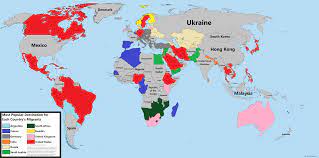HÀNH TRÌNH MỤC VỤ DI DÂN
ĐỒNG HÀNH VỚI NHỮNG ANH CHỊ EM DI DÂN KHẮP THẾ GIỚI....
Global AgendaMigrationFuture of WorkFuture of Economic Progress
Global migration, by the numbers: who migrates, where they go and why
Migrants make up 3.5% of the world's population.
Image: Unsplash/Jordan Sanchez
10 Jan 2020
- Charlotte EdmondSenior Writer, Formative Content
UpLink - Take Action for the SDGs
Most Popular
Debbie-Ann Shirley · The Conversation 20 May 2021
'Jobs of the now': The jobs of the future have arrived early - here are the top 10
COVID-19: What you need to know about the coronavirus pandemic on 21 May
Forum in focus
Closing the disability inclusion gap with business leadership
Explore context
Migration
Explore the latest strategic trends, research and analysis
- There are an estimated 272 million international migrants – 3.5% of the world’s population.
- While most people leave their home countries for work, millions have been driven away due to conflict, violence and climate change.
- Most migrants come from India; the United States is the primary destination.
There are an estimated 272 million international migrants around the world. And while that equals just 3.5% of the world’s population, it already surpasses some projections for 2050. Since 1970, the number of people living in a country other than where they were born has tripled.
The scale and speed of migration – defined by the International Organization for Migration (IOM) as the movement of persons away from their place of usual residence, either across an international border or within a state – is notoriously difficult to predict given it can go hand in hand with events such as severe instability, economic crisis or conflict.
Have you read?
While the overall figure has remained relatively stable as a proportion of the global population, the numbers from the World Migration Report 2020, published by the International Organization for Migration (IOM), clearly demonstrate the impact that events of the past two years have had on the movement of people around the world.
International migration around the world, by the numbers
Image: IOM World Migration Report 2020
Conflict in countries including Syria, Yemen, the Central African Republic, the Democratic Republic of the Congo and South Sudan, as well as the kind of extreme violence that forced Rohingya to seek safety in Bangladesh, have led to the displacement of millions of people.
Although refugees and internally displaced persons make up a relatively small portion of the total number of migrants, they are often most in need of help.
How is the World Economic Forum helping to improve humanitarian assistance?
Show
Climate change and weather-related hazards have also driven many people away from their homes, particularly in Mozambique, the Philippines, China, India and the United States.
But the overwhelming reasons most migrants leave their home are related to work, family or study.
Migrants' primary destinations
India continues to be the main origin of international migrants, with 17.5 million Indian-born people living abroad. Mexico and China both also have more than 10 million former residents spread around the world.
More than 40% of all international migrants worldwide in 2019 were born in Asia.
Image: World Migration Report 2020
The United States is the primary destination for migrants, though as a proportion of its population, the United Arab Emirates has the largest migrant contingent.
Migration has been a key contributor to population change in some countries, such as Equatorial Guinea, where the proportion of international migrants as a percentage of the country’s population has increased sharply in recent years. Nearly 17% of people now living in Equatorial Guinea are migrants, compared to less than 1% as recently as 2005.
Gulf Cooperation Council states also have seen significant population changes as a result of migration. With many people moving to the region for work, migrants make up the majority of the population in GCC countries with the exception of Oman and Saudi Arabia.
With the total number of refugees the highest on record, Turkey was the biggest host nation for the fifth consecutive year, taking in millions of refugees, particularly from Syria.
The number of refugees and internally displaced persons has doubled in the past 10 years.
Image: World Migration Report 2020
Dangerous journeys
In the wake of the death of hundreds of people when two boats sank near the Italian island of Lampedusa in 2013, the International Organization for Migration started tracking the numbers of people dying on migratory routes worldwide.
In the five years since, more than 30,900 people have lost their lives trying to reach other countries. The Mediterranean sea remains the deadliest route, claiming the lives of nearly 18,000 people in that time. Since 2014, over 1,800 deaths have been recorded along the border between the United States and Mexico.
Share
License and Republishing
Written by
Charlotte Edmond , Senior Writer, Formative Content
The views expressed in this article are those of the author alone and not the World Economic Forum.
-----------------------------------------------------------------------------------------------------------------------
Viết đánh giá
Tên bạn:Đánh giá của bạn: Lưu ý: không hỗ trợ HTML!
Bình chọn: Xấu Tốt
Nhập mã kiểm tra vào ô bên dưới:
















.png)






